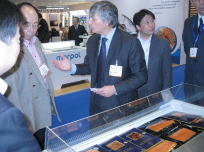Column #6
May 18, 2015

Japan’s food culture is something to treasure
Advisor, Mitsui & Co.Shoei Utsuda
◆My interests include diving and fishing
 Fishing for horse mackerel in Oita
Fishing for horse mackerel in Oita
My love of the sea ties in with my love of fish too. My appetite often takes me out fishing as a result. While it’s fun to actually catch fish, the most enjoyable thing about fishing is getting to eat the delicious fresh fish that you have caught. The list of fish I have caught and eaten is endless. Red sea bream, horse mackerel, flounder, trout, chub mackerel, cutlass fish…. Who knows how many different species of fish we eat here in Japan?
As a country, Japan really is blessed with marine resources. We may not have much land, but our economic waters are the sixth largest in the world. We have a huge variety of cooking techniques too, from preparing raw fish such as sashimi or sushi, to boiling, grilling, frying, steaming and mincing. Eating delicious Japanese food makes me feel glad I was born in Japan.
◆What I found at a seafood fair in Belgium
But what about fish eating habits elsewhere in the world? Roughly two years ago, I went to the European Seafood Expo, one of the world’s largest seafood trade fairs, held annually in Brussels, Belgium. I was most surprised by the fact that 30-40% of the fish being exhibited there were salmon. Adding in white fish such as sea bass and black sea bream took the total to around half. Being confronted with that reality made me realize just how diverse and amazing our seafood culture is in Japan. The problem is that many Japanese people are unaware of this precious resource that we have.
As if to prove that fact, more than 1,500 companies from around the world exhibited in the fair, but only two of them were Japanese companies. You could take that as a prime example of the Japanese fishery industry being focused solely on the domestic market. Amongst the Chinese exhibitors meanwhile, I noticed a number of products with large Japanese characters printed on their packaging. The aim is presumably to make consumers believe that they are from Japan, in an effort to piggy-back on the high quality image of “Made in Japan” products. Surely we need to do something about this situation.

 At the seafood fair in Belgium
At the seafood fair in Belgium

◆The state of Japanese restaurants around the world
You could say the same thing about overseas Japanese restaurants. We are in the midst of a boom in Japanese food around the world. It would be fair to say that you could find a Japanese restaurant in any city in the world these days. The quality of those restaurants tends to vary however. I recently went to a Japanese restaurant in the outskirts of Moscow. Surrounded by golden walls, a Kazakhstani waiter dressed in a kimono-style uniform brought over our food. One plate of very insubstantial food cost 8,000 yen!
Needless to say, there are conscientious Japanese restaurants and bars around the world too, providing an oasis for Japanese people working overseas or traveling on business. I once went to a fantastic Japanese restaurant in Accra, the capital of Ghana in Africa. You would almost think you were in Japan, from the food right through to the fittings and plates.
◆Accreditation system for Japanese food
Nonetheless, Japanese restaurants are still springing up like bamboo shoots after the rain, being opened all over the world by people who don’t know the first thing about Japanese food. This is a serious situation. I often wonder if it would be possible to establish a specialist accreditation system for Japanese food, along the same lines as the True Neapolitan Pizza Association. If we had a system like that, I’m sure people would come over to Japan from other countries to learn the correct ways of cooking Japanese food. Another option would be to establish schools specializing in Japanese food around the world.
Japanese food achieved cultural heritage status the year before last, but we still need to come up with new ideas to effectively promote authentic Japanese food around the world. We need to do more from a business standpoint too.
We need to recognize and make the most of the genuinely “cool” aspects of Japan, in terms of our expertise and skill in cooking the various species of fish that live in the waters surrounding the Japanese archipelago to perfection. That is something we as a country should treasure.
PROFILE
Shoei Utsuda
Director, Mitsui & Co. / Director, Cool Japan Fund
After joining Mitsui & Co. in April 1967, he studied at Dartmouth College in the US as an overseas trainee. His cross-cultural and multi-cultural experience went on to have a profound impact on his personal development and career after that point. Having spent five years living in the UK during his mid 30s, he went on to focus on promoting international business, particularly in areas such as power plants and the information industry.
He was appointed President and CEO in 2002. Through dedication to “doing a good job” in every aspect of his work, he managed to reconfigure the company as a whole and transform employees’ attitudes.
He was appointed Chairman in 2009, and continued serving in that role until retiring at the end of March 2015. He has also been a Director at Cool Japan Fund and the chairman of the Investment committee since 2013.













